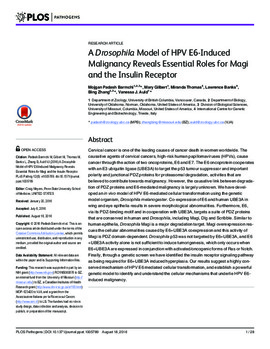| dc.contributor.author | Mojgan Padash Barmchi | |
| dc.contributor.author | Mary Gilbert | |
| dc.contributor.author | Miranda Thomas | |
| dc.contributor.author | Lawrence Banks | |
| dc.contributor.author | Bing Zhang | |
| dc.contributor.author | Vanessa J. Auld | |
| dc.date.accessioned | 2017-03-05T23:41:03Z | |
| dc.date.available | 2017-03-05T23:41:03Z | |
| dc.date.issued | 2016-08-18 | |
| dc.identifier.citation | Padash Barmchi M, Gilbert M, Thomas M, Banks L, Zhang B, Auld VJ (2016) A Drosophila Model of HPV E6-Induced Malignancy Reveals Essential Roles for Magi and the Insulin Receptor. PLoS Pathog 12(8): e1005789. doi:10.1371/journal.ppat.1005789 | en_US |
| dc.identifier.uri | https://hdl.handle.net/11244/49300 | |
| dc.description | We would like to thank Drs. Vivian Budnik, Herbert Jäckle, Larry Reiter, Andreas Wodarz, for generously providing reagents, the Bloomington Drosophila Stock Center, and the Confocal facility at University of Oklahoma (supported by a Major Research Instrumentation grant DBI-1126578 from the National Science Foundation to B. Zhang, R. Hewes, B. Holt, D. McCauley, and M. Nanny) for the use of the confocal microscope. We also thank Dr. David McCauley and Dr. Randall Hewes for discussions and sharing equipment. We thank the Developmental Studies Hybridoma Bank (University of Iowa, Department of Biology, Iowa City) for antibodies. | en_US |
| dc.description | | en_US |
| dc.description.abstract | Author Summary Human papillomaviruses (HPV) are the causative agents of cervical cancer, one of the leading causes of cancer death in women worldwide. The E6 oncoprotein encoded by HPV has been implicated in the progression of primary tumors to metastatic disease and we have developed a new model in the fruit fly (Drosophila melanogaster) to study the cellular effects of E6. The E6 protein recruits an E3 ubiquitin ligase (UBE3A) to induce the degradation of a number of cellular proteins, including members of the MAGUK family of scaffolding proteins that control the structure and polarity of epithelial cells: Dlg, Scribble and Magi. Expression of E6 and human UBE3A in the wing and eye of Drosophila disrupted these tissues. Similar to human cells we found that Drosophila Magi was a major E6 degradation target and that overexpression of Magi rescued the tissue disruption. However, Drosophila p53 was not degraded by E6/UBE3A, making our fly model potentially useful for studying the p53-independent activities of the E6+UBE3A complex. When we paired E6 expression with oncogenic proteins, including activated Ras, we observed that epithelia were transformed into mesechymal-like cells that left the epithelium and spread through the body. As a test of the potential of our system, we carried out a pilot genetic screen and identified the insulin receptor as a strong modulator of the E6-mediated disruption of Drosophila tissues. Therefore, we have developed a new system and approach to help us better understand the mechanisms that underlie how HPV infection leads to cell transformation and cancer. | en_US |
| dc.language.iso | en_US | en_US |
| dc.publisher | PLoS Pathogens | |
| dc.relation.ispartofseries | PLoS Pathog 12(8): e1005789 | |
| dc.relation.uri | http://www.plospathogens.org/article/info%3Adoi%2F10.1371%2Fjournal.ppat.1005789 | |
| dc.rights | Attribution 3.0 United States | |
| dc.rights.uri | https://creativecommons.org/licenses/by/3.0/us/ | |
| dc.subject | Eyes,Drosophila melanogaster,Apoptosis,Insulin signaling,Insulin,Phenotypes,Carcinogenesis,Imaginal discs | en_US |
| dc.title | A Drosophila Model of HPV E6-Induced Malignancy Reveals Essential Roles for Magi and the Insulin Receptor | en_US |
| dc.type | Research Article | en_US |
| dc.description.peerreview | Yes | en_US |
| dc.description.peerreviewnotes | http://www.plospathogens.org/static/editorial#peer | en_US |
| dc.identifier.doi | 10.1371/journal.ppat.1005789 | en_US |
| dc.rights.requestable | false | en_US |

